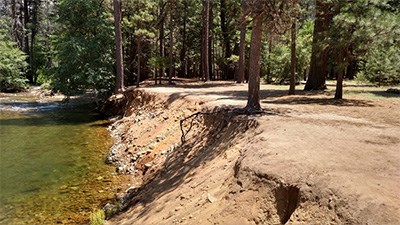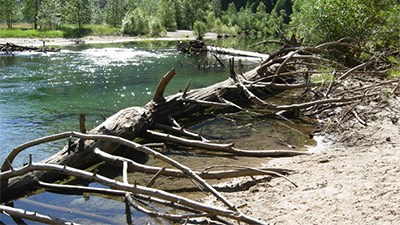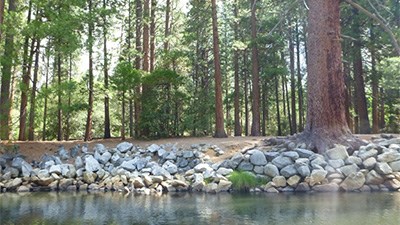
Ecological restoration is the process of assisting the recovery of an ecosystem that has been damaged or destroyed, as an intentional activity that initiates or accelerates the recovery of an ecosystem with respect to its health, integrity and sustainability (SER 2004). The overarching goal of ecological restoration is not to return to a particular point in time but rather to restore ecosystem processes, structure, and composition (Falk et al. 2006). Ecological RestorationThe Merced River Plan (MRP) identifies both passive and active ecological restoration actions to restore these natural and cultural processes. Passive restoration actions include fencing and signing sensitive areas. They are intended to halt human impacts and allow natural processes to repair damage. Active restoration actions include brush layering, revegetation, prescribed burning, removal of abandoned infrastructure, strategic placement of large wood, road removal, and removal of formal and informal trails in sensitive areas. These actions are intended to stabilize riverbanks, accelerate ecosystem recovery and promote diversity of meadow and riparian habitats, the health of ethnographic resources, and reduction in conifer encroachment in meadows. The restoration actions protect and enhance the biological, hydrologic/geologic and cultural Outstandingly Remarkable Values as well as free-flowing condition and water quality, collectively referred to as River Values in the Merced River Plan. 
In the river corridor, particularly in Yosemite Valley, the need for ecological restoration is apparent due to impacts to meadow function (fragmentation, trampling, and conifer encroachment), decreased meadow size, reduction in the health of California black oak communities, and loss of riparian habitat due to disruptions in both hydrological processes and cultural processes such as the cessation of burning by American Indians. These natural and cultural processes have been hindered by water diversions (such as ditches), channelization (bridges and riprap), road and bridge building, roadside parking, removal of large wood from the river channel, trampling of riverbanks and meadows, introduction of invasive plants and limited opportunities to reintroduce fire on the landscape. These actions have led to changes in hydrologic regime, channelization, river widening, decreased vegetation structural complexity and diversity, a reduction in the extent of meadows, and reduction in habitat quality. 
Riverbanks
Restoring Plant Communities on RiverbanksVegetation on the banks of the Merced River is often trampled and thinned, thereby removing roots that stabilize the soil. Much of the soil found on the banks of the Merced River is easily eroded when not held together by plant roots. By revegetating the riverbanks with native riparian plant species, eroded riverbanks are rebuilt to create complex plant communities that provide valuable habitat for aquatic and terrestrial species. These restoration areas may be fenced off for multiple years while the vegetation recovers. 
Restoring Large Wood Pieces to the Merced RiverTrees and wood pieces that fall into the river become an integral part of the river ecosystem. Many species depend on the complex habitat that forms around large wood in the channel. Between 1880 and 1993, large wood was removed from the river. We now realize the value of leaving large wood in place and supplement naturally felled wood with placed wood structures. 
Removing RiprapRestoration efforts involve removing riprap that is no longer functional, or replacing riprap with bioengineered structures made of large wood that are designed to incorporate live plants that will naturally stabilize the bank and enhance riparian habitat.Since the late 1880s, many of the rivers and creeks in Yosemite have been lined with large stones, called riprap, to prevent the river from naturally eroding banks. Holding the river channel in place protects roads and buildings and other infrastructure from being damaged by the river, especially during floods. However, little vegetation colonizes riprapped areas, and the riprap can cause the river to unnaturally widen or scour out deep pools. By removing riprap that has already collapsed and is no longer functional, or replacing riprap with bioengineered structures that can serve the same function as the riprap, we can enhance riparian habitat while still protecting infrastructure. Riverbank Restoration Projects2016Riverbank restoration work focused on narrowing the river channel in the former Upper River campground area. In this area, the riverbanks are eroded and the river channel has substantially and unnaturally widened. In some places the river channel has increased its width by 51 feet from when it was mapped in 1919. Rivers can naturally build banks back through a process in which riparian vegetation slows down water and causes sediment and organic matter to deposit near the bank. Tree trunks and branches that fall into the river can also slow down the river flow, causing sediment deposition. Many species take advantage of the varied habitat that forms around large wood in the channel. This project was meant to accelerate bank rebuilding by securing incense cedar and ponderosa pine trees in the river as well as planting riverbanks with willows, cottonwoods, alders, and sedges. This area is currently fenced off to allow the vegetation to establish. 
2017River restoration work continued with bank re-building just downstream of the 2016 project site. 
2018Riverbank restoration work focused on the Housekeeping Camp project. Riprap on the bank was removed with heavy equipment and replaced with a large wood structure. The bank was planted with native vegetation. The cabins on the eastern border of Housekeeping Camp are built on the outside of a river bend, an area which would naturally erode. To stop erosion, we placed riprap (large rocks) on the riverbank in the past, but the erosion has continued, noticeably in the past two years (2016-2017) during large floods. We replaced the riprap with a bioengineered wood structure, which uses natural processes to stabilize the bank. Large wood pieces provide a platform for vegetation to colonize the bank, eventually stabilizing the bank with their roots and their ability to slow water down. 2018 Housekeeping Camp Restoration Project 

Left image
Right image
2018 Housekeeping Camp Restoration Project 

Left image
Right image
2019Riverbank restoration work focused on the Swinging Bridge site. Riprap was removed from the bank and replaced with a large wood structure and native vegetation. Riverbank restoration at the Swinging Bridge picnic area occurred over a period of nine weeks in the fall of 2019. The goal of the project was to improve riparian habitat and riverbank stability. National Park Service staff used heavy equipment to restore eroded and armored riverbanks on the southern border of Swinging Bridge by removing approximately 200 linear feet of riprap. The riprap was replaced with an engineered log structure and the area was revegetated with thousands of native riparian plants. 2019 Swinging Bridge Restoration Project 

Left image
Right image

2020Riverbank restoration work continues with a project to remove riprap just upstream of Stoneman Bridge. |
Last updated: July 2, 2024
